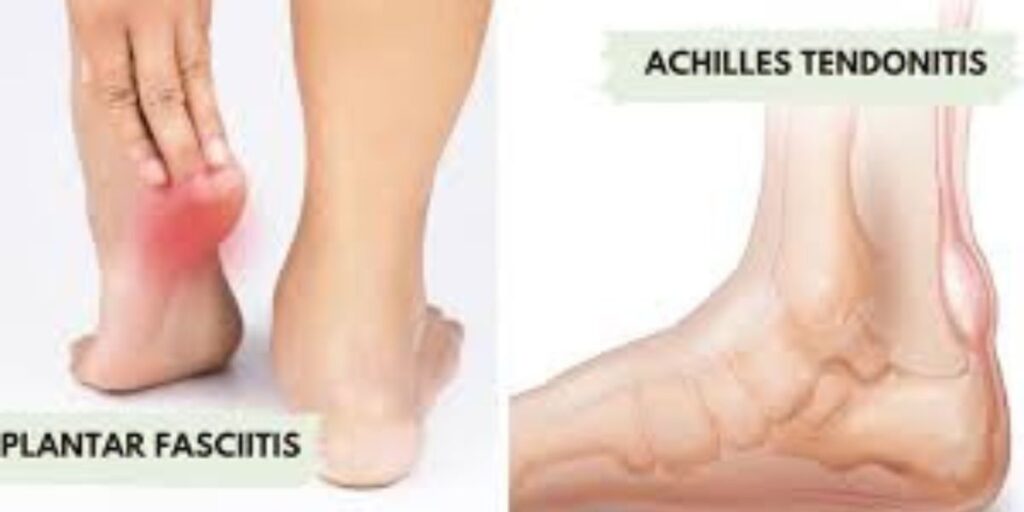Plantar fasciitis vs Achilles tendinitis are two of the most common causes of heel pain and discomfort in the foot. Both conditions affect vital structures that play a key role in foot biomechanics, making everyday activities like walking or running difficult. Plantar fasciitis involves inflammation of the thick band under the foot, while Achilles tendinitis impacts the tendon connecting the calf to the heel. They often share symptoms such as stiffness, swelling, and tenderness, yet their causes and treatment approaches can differ. Understanding these conditions, recognizing early warning signs, and seeking proper care are essential for faster recovery and long-term heel injury recovery.
Understanding the Achilles Tendon and Plantar Fascia
The Achilles tendon is the thick band that connects your calf muscles to your heel bone. It is the strongest tendon in your body and handles the force from pain when running, jumping, or even walking up stairs. Without it, you couldn’t push off the ground or walk normally.
The plantar fascia is a strong ligament that runs along the bottom of your foot, from your heel to your toes. It supports your arch and absorbs shock with every step. Problems here often lead to pain in bottom of foot and morning heel pain. Both structures are vital in foot biomechanics, and when one is injured, it often affects the other.
What Is Achilles Tendonitis?
Achilles tendonitis happens when the tendon becomes inflamed due to overuse injury or sudden increase in activity. Many athletes, especially runners, experience Achilles tendon pain after pushing too hard. The pain is often felt as pain in back of heel or stiffness when waking up.
Common causes include poor stretching habits, unsupportive shoes, and overstretch injury from sports. This condition is more common in people with high arches or flat feet due to changes in how pressure is placed on the tendon during movement.
What Is Plantar Fasciitis?
Plantar fasciitis is inflammation of the plantar fascia, often linked to foot inflammation caused by repetitive stress. The main symptom is plantar heel pain, which can feel like a stabbing sensation during your first steps in the morning.

Risk factors include long hours on your feet, carrying excess weight, and wearing shoes without proper arch support. People with runners heel pain or those in jobs that require standing for hours often face this issue.
Similarities Between Achilles Tendonitis and Plantar Fasciitis
Both conditions lead to heel pain, heel stiffness, and sometimes heel swelling. The discomfort can spread to nearby areas, making it hard to pinpoint the exact source without a heel injury diagnosis.
In both cases, sports injuries and sudden activity changes are common triggers. Without proper treatment, these issues can limit movement and delay heel injury recovery for weeks or even months.
Key Differences Between Achilles Tendonitis and Plantar Fasciitis
With Achilles tendonitis, pain is usually felt as pain in back of heel and worsens with uphill walking or sprinting. With plantar fasciitis, pain in bottom of foot is more common, especially during the first steps of the day.
Table: Main Differences
| Feature | Achilles Tendonitis | Plantar Fasciitis |
| Pain location | Back of heel | Bottom of heel |
| Pain timing | Worsens with activity | Worse in the morning |
| Swelling | Along tendon | Near heel bone |
How to Tell Which Condition You Have
You can try a few checks at home. If pressing the back of your heel causes sharp Achilles tendon pain, it may be tendonitis. If pressing the bottom of your heel triggers plantar heel pain, the plantar fascia is likely involved.
Still, only a professional can give a clear heel injury diagnosis. Sometimes, imaging for foot injuries like ultrasound or MRI is needed to confirm the cause.
Prevention Tips for Both Conditions
Wearing supportive shoes with good arch support is the first step in heel pain prevention tips. Replace worn-out footwear regularly to avoid uneven pressure.
Daily foot stretching exercises help maintain flexibility. Warm up before sports and avoid sudden changes in workout intensity to reduce overuse injury risk.
Treatment Options for Achilles Tendonitis
Most people improve with non-surgical foot pain treatments like rest, ice, compression, elevation (RICE). Taking breaks from activities that cause pain is essential for healing.
Physical therapy for tendon injuries helps strengthen the calf muscles and restore normal foot biomechanics. In severe cases, advanced therapies like shockwave treatment may be needed.
Treatment Options for Plantar Fasciitis
For plantar heel pain, rest is important, but targeted stretching is key. Massaging the arch and using orthotic inserts can ease pressure. Some people benefit from night splints to keep the fascia stretched overnight.
If pain continues, options include sports therapy for heel pain or steroid injections. These can reduce inflammation in the heel and speed heel injury recovery.
When Pain May Indicate a More Serious Problem
If you hear a pop with sudden pain when walking, it might signal a torn tendon. This often requires surgical treatment for heel pain.
Chronic foot tendon injury or repeated foot inflammation can cause lasting damage. Getting help early is the best way to prevent permanent issues.
FAQs
Can you have Achilles tendonitis and plantar fasciitis at the same time?
Yes, both conditions can occur together, especially in people with poor arch support or repetitive strain.
How to treat Achilles tendonitis and plantar fasciitis?
Treatment often involves rest, stretching, supportive shoes, and targeted physical therapy.
What flares up Achilles tendonitis?
Overuse, overstretch injury, sudden activity changes, and unsupportive footwear can trigger it.
What are two signs of Achilles tendonitis?
Common signs include Achilles tendon pain at the back of the heel and morning stiffness.
Welcome to Heel Tooth! I’m Lee Marvin.

